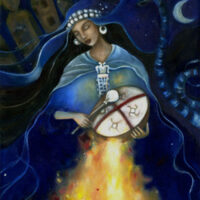Kueyen : The Moon Goddess
Listen
At a glance
| Description | |
|---|---|
| Origin | Mapuche Mythology |
| Classification | Gods |
| Family Members | Antu (Husband) |
| Region | Chile, Argentina |
| Associated With | Moon, Stars |
Kueyen
Introduction
In the heart of Mapuche mythology, the moon is not simply a celestial object but a revered spiritual entity known as Kueyen. Her presence illuminates more than just the night sky—she embodies cycles, harmony, femininity, and cosmic order. For the Mapuche people of Chile and Argentina, Kueyen is central to their worldview, where every natural phenomenon carries a deeper spiritual significance. More than a myth, she is a guardian and guide whose presence is still felt today in cultural, spiritual, and even scientific spheres.
Physical Traits
Kueyen’s essence is rooted in the shifting phases of the moon, each one representing a different stage of life and energy. Her form is believed to reflect these changes, transitioning fluidly between youth, motherhood, and old age. In the new moon phase, she symbolizes innocence and beginnings, while the full moon reveals her as a nurturing and radiant figure. During the waning phase, she is associated with wisdom and the natural winding down of life’s cycles. The glow she emits is not only visual but spiritual—a subtle force that inspires introspection, healing, and renewal. This ever-changing appearance underlines her dynamic nature and her close ties to both the physical and emotional rhythms of life.
Family
Kueyen shares a significant connection with Antu, the sun spirit and one of the most powerful beings in Mapuche cosmology. As her celestial counterpart and husband, Antu represents masculine energy, wisdom, and vitality, while Kueyen brings balance through her association with the feminine, emotional depth, and night. Their relationship is symbolic of the equilibrium between light and dark, day and night, logic and intuition. This partnership reflects the holistic balance the Mapuche strive for in their lives and spiritual practices. Their bond is also visible in the phenomenon of eclipses, seen as moments of cosmic unity between sun and moon, a fleeting merging of power and presence that reaffirms their deep connection.
Other names
While she is most commonly known as Kueyen, variations of her name such as Küyen or Kuzeney also appear in oral traditions. These names are not just labels but carry deep cultural resonance, referring simultaneously to the moon as a physical body and as a sacred spirit. In some sources, she is mentioned alongside Elchey, a representation of the Earth, illustrating the interconnectedness of the natural world within Mapuche beliefs. Occasionally, confusion arises when she is mistakenly identified as Anchimallen—a different type of spirit entirely. Anchimallens are magical or shapeshifting beings, not celestial deities, and this mix-up highlights the complexities and overlaps found in indigenous mythologies.
Powers and Abilities
Kueyen is much more than a passive moon goddess; she is a commanding spiritual leader. As the highest-ranking wangulen—the star spirits—she is entrusted with guiding the other celestial beings and maintaining harmony in the night sky. Her influence extends to the tides, fertility cycles, and even emotional and psychological states, especially those linked to intuition and dreaming. As a powerful Pillán spirit, her abilities touch on all aspects of life and nature. She oversees the movement of water, supports agricultural rhythms, and safeguards women’s health, particularly in connection with menstruation and childbirth. Her lunar cycle is seen as a guiding pattern for natural growth and decline, marking her as a figure of immense importance in both the cosmic and earthly realms.
Modern Day Influence
Kueyen’s influence is not confined to mythological texts or ancient traditions. In the modern world, she remains a symbol of cultural identity and spiritual wisdom. One of the most notable acknowledgments of her legacy is the naming of one of the four units of the Very Large Telescope (VLT) at the European Southern Observatory (ESO) in Chile as “Kueyen.” This nod to her celestial status bridges indigenous heritage with contemporary science, reflecting a growing appreciation for traditional knowledge systems.
In art and literature, Kueyen continues to inspire. Mapuche artists and writers draw on her symbolism to express themes of identity, femininity, and resistance. A striking example is the 2012 painting titled Küyen, which channels the spirit of Mapuche cosmology through vibrant visuals, reinforcing her relevance in today’s cultural dialogues. Additionally, her name and image appear in eco-spiritual movements that promote lunar gardening, nature-based rituals, and a return to ancestral ways of living in harmony with the Earth.
In indigenous rights campaigns, Kueyen serves as a potent emblem of female empowerment and environmental protection. She is often cited in discussions around the preservation of indigenous knowledge and the role of women in traditional societies. Her mythology provides a framework for understanding the universe not as a mechanical system but as a living, breathing entity where each element plays a vital spiritual role.
The continued reverence for Kueyen reflects how ancient deities remain deeply embedded in cultural consciousness. She stands as a reminder of the importance of rhythm, balance, and respect for natural cycles—a message that resonates in a world increasingly disconnected from such principles.
Related Images
Source
Calbucura, J. (n.d.). Kueyen ESO. European Southern Observatory. Retrieved from https://www.eso.org/public/teles-instr/paranal-observatory/vlt/vlt-names/kueyen/
Gods and Monsters. (n.d.). Kueyen: Moon Spirit of Light, Love, and Mapuche Sky Lore. Retrieved from https://godsandmonsters.info/kueyen/
Wikipedia contributors. (n.d.). Kueyen. Wikipedia. Retrieved from https://en.wikipedia.org/wiki/Kueyen
Trivero, A. (1999). Trentrenfilú, Proyecto de Documentación Ñuke Mapu. Ñuke Mapu Documentation Project.
Coña, P., & Moesbach, W. (2000). Memorias de un cacique Mapuche. Santiago de Chile: Ediciones Pehuén.
Cañumil, T. (2015). Astronomía Mapuche. Universidad Nacional de Quilmes.
Augusta, F., Painemilla Ñamcucheu, P., Colüñ, J., & Huenuñamco, D. (2007). Diccionario Mapuche. Santiago de Chile: Ediciones Cerro Manquehue.
Frequently Asked Questions
What is lorem Ipsum?
I am text block. Click edit button to change this text. Lorem ipsum dolor sit amet, consectetur adipiscing elit. Ut elit tellus, luctus nec ullamcorper mattis, pulvinar dapibus leo.
What is lorem Ipsum?
I am text block. Click edit button to change this text. Lorem ipsum dolor sit amet, consectetur adipiscing elit. Ut elit tellus, luctus nec ullamcorper mattis, pulvinar dapibus leo.
What is lorem Ipsum?
I am text block. Click edit button to change this text. Lorem ipsum dolor sit amet, consectetur adipiscing elit. Ut elit tellus, luctus nec ullamcorper mattis, pulvinar dapibus leo.
What is lorem Ipsum?
I am text block. Click edit button to change this text. Lorem ipsum dolor sit amet, consectetur adipiscing elit. Ut elit tellus, luctus nec ullamcorper mattis, pulvinar dapibus leo.
What is lorem Ipsum?
I am text block. Click edit button to change this text. Lorem ipsum dolor sit amet, consectetur adipiscing elit. Ut elit tellus, luctus nec ullamcorper mattis, pulvinar dapibus leo.








